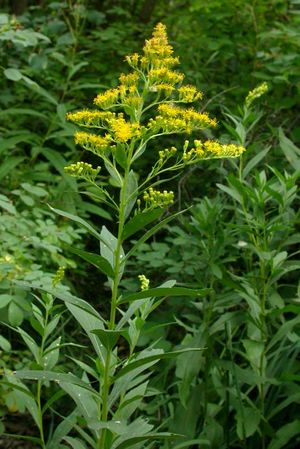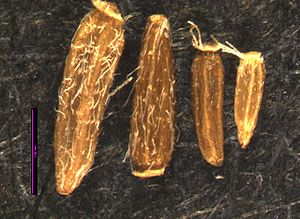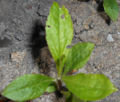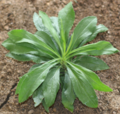Difference between revisions of "Solidago lepida"
m (→Photo Gallery) (Tag: VisualEditor) |
(→Description) (Tag: VisualEditor) |
||
| (8 intermediate revisions by 2 users not shown) | |||
| Line 1: | Line 1: | ||
| − | + | *Scientific Name: ''Solidago lepida'' | |
| − | + | ||
| − | *Scientific Name: Solidago | + | |
*Family: Asteraceae | *Family: Asteraceae | ||
| − | * | + | *Common Name: West Canadian goldenrod |
| − | ==Taxonomy== | + | *Synonyms/Misapplications: ''Solidago canadensis'' |
| − | + | *Codon: SOLLEP | |
| − | + | ---- | |
| − | + | [[File:SOLLEP1.jpg|thumb|Photo by Ben Legler, also featured on Main Page.]] | |
| − | + | ===Taxonomy=== | |
| − | + | {{Taxobox | |
| − | + | | name = | |
| − | + | | regnum = [[Plant]]ae | |
| − | * | + | | subregnum = Viridiplantae |
| − | * | + | | phylum = Tracheophyta |
| − | ==Description== | + | | subphylum= Spermatophytina |
| − | + | | classis = Magnoliopsida | |
| + | | subclassis = Asteranae | ||
| + | | ordo = Asterales | ||
| + | | familia = Asteraceae | ||
| + | | genus = ''Solidago'' L. | ||
| + | | species = '''''Solidago lepida''''' DC. | ||
| + | | subspecies = | ||
| + | | synonyms = *''Solidago canadensis'' var. ''lepida ''(DC.) Cronquist | ||
| + | *''Solidago canadensis'' var.'' subserrata'' (DC.) Cronquist | ||
| + | }} | ||
| + | <ref>Integrated Taxonomic Information System. Retrieved from https://www.itis.gov/servlet/SingleRpt/SingleRpt?search_topic=TSN&search_value=521727#null</ref> | ||
| + | |||
| + | ===Description=== | ||
| + | Erect perennial, forms patches from long creeping rhizomes. Stems leafy and hairy near the top, basally reduced, with a dense cluster of small yellow flowers. | ||
Height: Up to 5 feet (1.5 meters). | Height: Up to 5 feet (1.5 meters). | ||
| − | + | Leaves: Lacking well-developed basal leaves; stem leaves numerous and crowded, gradually reduced upwards; saw-toothed to entire; hairless to roughly hairy on upper and lower sides; leaves are prominently 3-veined. | |
| − | + | ||
| − | + | ||
| − | + | ||
| − | Leaves: Lacking basal leaves; stem leaves numerous and crowded, gradually reduced upwards; saw-toothed to entire; hairless to roughly hairy on upper and lower sides; leaves are prominently 3-veined | + | |
| − | + | ||
| − | + | ||
| − | + | .Flowers: Numerous flower heads in dense pyramidal cluster; ray flowers 10-17, 1-3 mm long; involucres 3-6mm x 3-5mm, long-pointed bracts that sometimes overlap, sometimes sticky and glandular.<ref name=":1">WTU Herbarium, Burke Museum, | |
| − | Flowers: Numerous flower heads in dense pyramidal cluster; ray flowers 10-17, 1-3 mm long; involucres 3-6mm x 3-5mm, long-pointed bracts that sometimes overlap, sometimes sticky and glandular. | + | & University of Washington. Retrieved from https://biology.burke.washington.edu/herbarium/imagecollection/taxon.php?Taxon=Solidago%20lepida</ref><ref name=":0">Hitchcock, C. L., Cronquist, A., Giblin, D., & Legler, |
| + | B. et al. (2018). ''Flora of the Pacific Northwest: an illustrated manual''. | ||
| + | Seattle: University of Washington Press.</ref>[[File:SOCA LisaHintz sd 2012.jpg|thumb|300px|''Solidago lepida'' seed. Photo by Lisa Hintz]] | ||
| − | ==Bloom Period== | + | ===Bloom Period=== |
| − | + | July-October<ref name=":1" /> | |
| − | ==Distribution== | + | ===Distribution=== |
| − | + | Widespread on both sides of the Cascades, Alaska to California, east to Rocky Mountains and eastern Canada.<ref name=":0" /> | |
| − | ==Habitat== | + | ===Habitat=== |
| − | ===Ecological Setting=== | + | ====Ecological Setting==== |
| − | + | Fields, meadows, thickets, and shorelines, roadsides and disturbed sites; low to mid elevations.<ref name=":0" /> | |
| − | ===Soil Texture=== | + | ====Soil Texture==== |
Coarse, medium, or fine. | Coarse, medium, or fine. | ||
| − | = | + | ====Soil Reaction / Salinity==== |
| − | + | ||
| − | ===Soil Reaction / Salinity=== | + | |
pH, Minimum 4.8 pH, Maximum 7.5 | pH, Minimum 4.8 pH, Maximum 7.5 | ||
<br>No salinity tolerance | <br>No salinity tolerance | ||
| − | = | + | ====Shade Tolerance==== |
| − | + | ||
| − | ===Shade Tolerance=== | + | |
Shade intolerant - mostly sunny 60%-80% | Shade intolerant - mostly sunny 60%-80% | ||
| − | ==Uses== | + | ===Uses=== |
| − | ===Wildlife=== | + | ====Wildlife==== |
Birds: The seeds of goldenrod are eaten by numerous bird species.<br> | Birds: The seeds of goldenrod are eaten by numerous bird species.<br> | ||
| − | Insects: The bright, showy flowers attract bumblebees and pine white, red admiral, and mylitta crescent butterflies. Syrphid flies and small wasps also frequently visit the goldenrod flowers. | + | Insects: The bright, showy flowers attract bumblebees and pine white, red admiral, and mylitta crescent butterflies. Syrphid flies and small wasps also frequently visit the goldenrod flowers.<ref>Plants that Provide Seeds and Berries. (2018). Retrieved from <nowiki>https://www.wnps.org/plant-lists</nowiki></ref> |
| − | ===First Nations=== | + | ====First Nations==== |
Infusion of roots and flowers used for flank pains; Infusion of flowers taken as an emetic; Compound infusion of tubers given to babies that start suddenly during sleep; Compound decoction used as wash for child who does not talk or laugh; Infusion of flower heads taken for diarrhea; Infusion of shoots given to children with fevers; Decoction of flower heads taken for the flu; Infusion of blossoms used for special kinds of fevers; Infusion of plant used as a bath for the parent at childbirth; Decoction of plant used as a bath for babies with diarrhea, sleeplessness or excessive crying; Decoction of plant tops taken for diarrhea; Decoction of plant and wild tarragon used as a wash for horses with cuts and sores; Crushed blossoms chewed for sore throat; Infusion of crushed blossoms taken for body pain; Seeds used for food; Roots steeped or eaten; Roots smoked with other tobaccos.<ref>Native American Ethnobotany Database. Retrieved from <nowiki>http://naeb.brit.org/uses/search/?string=solidago+canadensis</nowiki></ref> | Infusion of roots and flowers used for flank pains; Infusion of flowers taken as an emetic; Compound infusion of tubers given to babies that start suddenly during sleep; Compound decoction used as wash for child who does not talk or laugh; Infusion of flower heads taken for diarrhea; Infusion of shoots given to children with fevers; Decoction of flower heads taken for the flu; Infusion of blossoms used for special kinds of fevers; Infusion of plant used as a bath for the parent at childbirth; Decoction of plant used as a bath for babies with diarrhea, sleeplessness or excessive crying; Decoction of plant tops taken for diarrhea; Decoction of plant and wild tarragon used as a wash for horses with cuts and sores; Crushed blossoms chewed for sore throat; Infusion of crushed blossoms taken for body pain; Seeds used for food; Roots steeped or eaten; Roots smoked with other tobaccos.<ref>Native American Ethnobotany Database. Retrieved from <nowiki>http://naeb.brit.org/uses/search/?string=solidago+canadensis</nowiki></ref> | ||
| − | === | + | Gregory L. Tilford writes that the species within the ''Solidago'' genus may be used more or less interchangeably. He writes the greens can be eaten a cooked potherb, with variable palatibility, and the flowers make a nice sweetened tea. Dried leaves and flowers may be used as a styptic agent, and an infusion to reduce mucus production in the bronchi during a cold or flu. The tea is diuretic and regarded by him as a kidney tonic.<ref>Tilford, G. L. (1999). ''Edible and medicinal plants of the'' |
| + | west''. Missoula, MT: Mountain Press Pub. Co.''</ref> | ||
| + | ===Photo Gallery=== | ||
| + | <gallery> | ||
| + | File:SOLLEP2.png|Photo CNLM | ||
| + | File:SOLLEP3.png|Young plant, photo CNLM | ||
| + | File:SOCA LisaHintz sd 2012.jpg|photo by Lisa Hintz | ||
| + | </gallery> | ||
| − | == | + | ===References=== |
| − | + | <references /> | |
| − | + | ||
Latest revision as of 15:36, 30 June 2021
- Scientific Name: Solidago lepida
- Family: Asteraceae
- Common Name: West Canadian goldenrod
- Synonyms/Misapplications: Solidago canadensis
- Codon: SOLLEP
Contents
Taxonomy
| Scientific classification | |
|---|---|
| Kingdom: | Plantae |
| Subkingdom: | Viridiplantae |
| Phylum: | Tracheophyta |
| Subphylum: | Spermatophytina |
| Class: | Magnoliopsida |
| Subclass: | Asteranae |
| Order: | Asterales |
| Family: | Asteraceae |
| Genus: | Solidago L. |
| Species: | Solidago lepida DC. |
| Synonyms | |
| |
Description
Erect perennial, forms patches from long creeping rhizomes. Stems leafy and hairy near the top, basally reduced, with a dense cluster of small yellow flowers.
Height: Up to 5 feet (1.5 meters).
Leaves: Lacking well-developed basal leaves; stem leaves numerous and crowded, gradually reduced upwards; saw-toothed to entire; hairless to roughly hairy on upper and lower sides; leaves are prominently 3-veined.
.Flowers: Numerous flower heads in dense pyramidal cluster; ray flowers 10-17, 1-3 mm long; involucres 3-6mm x 3-5mm, long-pointed bracts that sometimes overlap, sometimes sticky and glandular.[2][3]Bloom Period
July-October[2]
Distribution
Widespread on both sides of the Cascades, Alaska to California, east to Rocky Mountains and eastern Canada.[3]
Habitat
Ecological Setting
Fields, meadows, thickets, and shorelines, roadsides and disturbed sites; low to mid elevations.[3]
Soil Texture
Coarse, medium, or fine.
Soil Reaction / Salinity
pH, Minimum 4.8 pH, Maximum 7.5
No salinity tolerance
Shade Tolerance
Shade intolerant - mostly sunny 60%-80%
Uses
Wildlife
Birds: The seeds of goldenrod are eaten by numerous bird species.
Insects: The bright, showy flowers attract bumblebees and pine white, red admiral, and mylitta crescent butterflies. Syrphid flies and small wasps also frequently visit the goldenrod flowers.[4]
First Nations
Infusion of roots and flowers used for flank pains; Infusion of flowers taken as an emetic; Compound infusion of tubers given to babies that start suddenly during sleep; Compound decoction used as wash for child who does not talk or laugh; Infusion of flower heads taken for diarrhea; Infusion of shoots given to children with fevers; Decoction of flower heads taken for the flu; Infusion of blossoms used for special kinds of fevers; Infusion of plant used as a bath for the parent at childbirth; Decoction of plant used as a bath for babies with diarrhea, sleeplessness or excessive crying; Decoction of plant tops taken for diarrhea; Decoction of plant and wild tarragon used as a wash for horses with cuts and sores; Crushed blossoms chewed for sore throat; Infusion of crushed blossoms taken for body pain; Seeds used for food; Roots steeped or eaten; Roots smoked with other tobaccos.[5]
Gregory L. Tilford writes that the species within the Solidago genus may be used more or less interchangeably. He writes the greens can be eaten a cooked potherb, with variable palatibility, and the flowers make a nice sweetened tea. Dried leaves and flowers may be used as a styptic agent, and an infusion to reduce mucus production in the bronchi during a cold or flu. The tea is diuretic and regarded by him as a kidney tonic.[6]
Photo Gallery
References
- ↑ Integrated Taxonomic Information System. Retrieved from https://www.itis.gov/servlet/SingleRpt/SingleRpt?search_topic=TSN&search_value=521727#null
- ↑ 2.0 2.1 WTU Herbarium, Burke Museum, & University of Washington. Retrieved from https://biology.burke.washington.edu/herbarium/imagecollection/taxon.php?Taxon=Solidago%20lepida
- ↑ 3.0 3.1 3.2 Hitchcock, C. L., Cronquist, A., Giblin, D., & Legler, B. et al. (2018). Flora of the Pacific Northwest: an illustrated manual. Seattle: University of Washington Press.
- ↑ Plants that Provide Seeds and Berries. (2018). Retrieved from https://www.wnps.org/plant-lists
- ↑ Native American Ethnobotany Database. Retrieved from http://naeb.brit.org/uses/search/?string=solidago+canadensis
- ↑ Tilford, G. L. (1999). Edible and medicinal plants of the west. Missoula, MT: Mountain Press Pub. Co.





